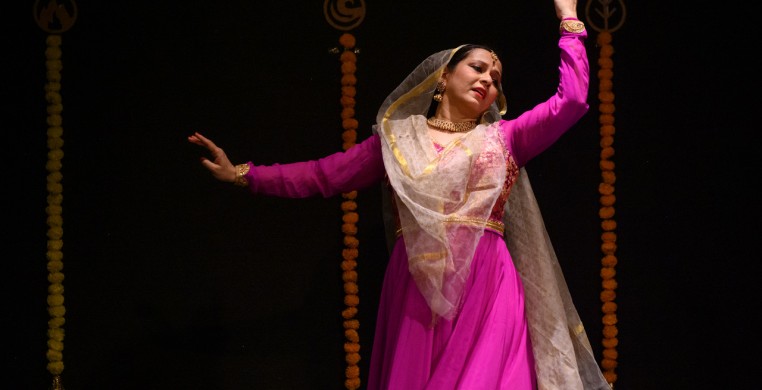Kathak dance originated two-thousand years ago in the temples of Northern India and is known for the way artists tell stories using expressive eye, hand and upper body movements while clothed in elaborate, colorful costumes. What sets it apart from other Indian and South Asian dance forms is the treatment of rhythm, with dancers beating out extremely complex patterns with different parts of their bare feet, augmented by bells, called ghungrus, strapped to their ankles.
On April 15, See Chicago Dance was fortunate to attend “Ehsaas: A Realization,” presented by the Illinois Center for Kathak at the Athenaeum. The program featured choreography and performance by Sandip Mallick, visiting guru from Kolkata, India, and local dancer, Shiwali Tenner. Set to music by Sunando Mukherjee, the work was accompanied by a live band playing tablas, harmonium, flute and vocal recitations. Students of the ICK also danced two short, graceful works by Tenner set to the song, “Tu Jhoom,” and dancers in wheelchairs perform elegantly to an original cover of Nina Simone’s “Feelin’ Good,” a collaboration with ReinventAbility.
Dancing solo, Tenner opens with three works choreographed by Mallick, each offering a different side of Kathak. In “Invocation of Lord Ganesha and Goddess Bhawani, Tenner warms up the floor with solid slaps of her feet while depicting the classic pose of the Bhawani or Durg in her body—right hand pointed up, left hand down, balanced on one leg, the other leg raised across her body.
Tenner gets down to business in “Kathak Pure (technical) Dance in 16 beats rhythmic cycle (Teen Tall).” The meter in the music rocks back and forth like a boat on the ocean, with the tablas producing swaying eighth-note triplets that speed up into quicker 16th note triplets, with Tenner’s feet pounding out an uneven two—four—three phrase against the swinging six-to-a-phrase groove. Dancer and musicians never break form, and just when you think that they’ve gotten lost in rhythmic outer space…Bang! They both hit sharp accents on the “one” of the next phrase, evenly spaced from the beginning of the last.
The temperature gets turned up even more in Ghazal: Aaj Jane Ki Jid as Tenner enters a “pure dance” style, transforming the same rhythm in a seven beats per phrase meter. Tenner builds to a climactic finish, a satisfying conclusion to Mallick’s suite.
 Shiwali Tenner and students from the Illinois Center for Kathak.
Shiwali Tenner and students from the Illinois Center for Kathak.
The second act features the eponymous Ehass: A Realization, also by Mallick. Tenner weaves around long, sheer fabrics of orange, blue and tan hung from the ceiling. Her movements embody the Pancha Bhuta, the five elements that, according to Hinduism, make up all of creation. Tenner ripples her hands and twists her body, the visual and the light tingling of bells imitating flowing water. Her arms spiral overhead and the momentum spinS her around as if being blown by a great wind. Flat palms press closer to a warm fire. “Ehass: A Realization” moves beyond narrative storytelling to communicate an abstraction of sights and sounds of Earth, water, air, fire and infinite space.
The program concludes with a solo by Sandip Mallick, whom the New York Times called “a dancing mathematician. Mallick produces technical wizardry, ostensibly using minimal effort. The slow drag of the ball of the foot makes the ghungru rattle like a shaking tambourine. Accented triplets—CHK-tsch-tsch, CHK-tsch-tsch—are produced by striking the ball of the foot, then the alternating heels two times. The dancing takes hold of the tempo from the musicians and builds to a rapid crescendo. Using the pronated and supinated edges of the sole, Mallick beats out complex beat divisions, like a phrase of 15 broken into one-two-three-four-five, or a four-beat phrase repeated five times plus an extra three counts on the end for a phrase of twenty-three… A dancer-mathematician indeed!
While all this is going on in the feet, Mallick embodies all manner of imagery. He’s an Olympic fencer with two snakes for arms. Hands splash water or peel fruit. The overwhelming blend of movement and music completely fills the space and your senses.
Chicago could use more performances like “Ehsaas: A Realization.” I felt like I received an education, not preachy or pretentious, but interesting and integrated into the dancing. The dedication of the dancers was apparent and lent itself to their performances. The combination of artistry, history and spirituality created an atmosphere that, despite the depth of the art form, remained accessible to novice and never-miss audiences alike.

